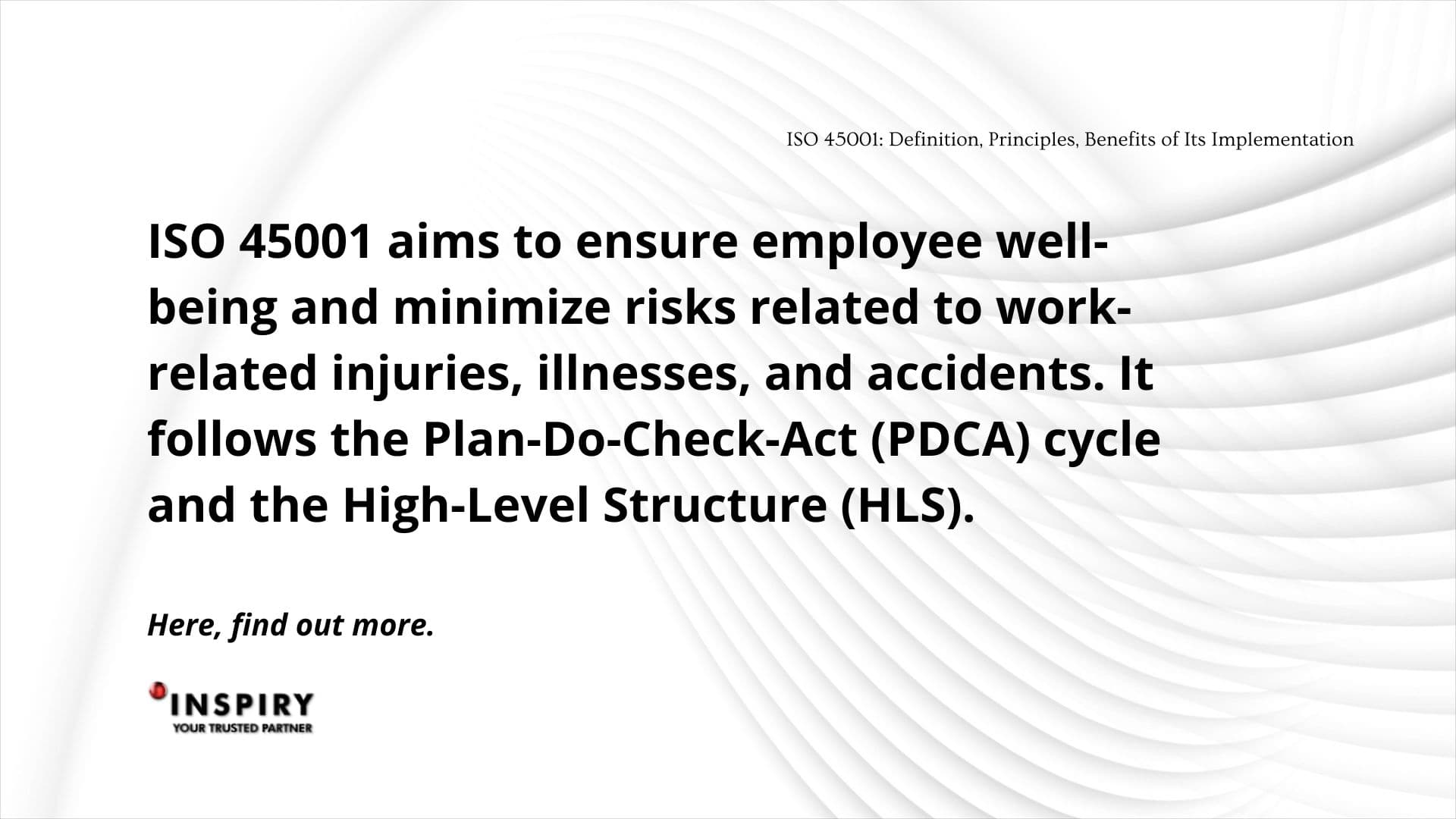
Blog Detail
ISO 45001: Definition, Principles, Benefits of Its Implementation

Definition:
ISO 45001 is an international standard for Occupational Health & Safety (OHS) management systems. ISO 45001 aims to ensure employee well-being and minimize risks related to work-related injuries, illnesses, and accidents. It follows the Plan-Do-Check-Act (PDCA) cycle and the High-Level Structure (HLS). The risk-based approach emphasized by ISO 45001 includes detecting hazards, evaluating risks, and putting in place controls to lessen those risks. It promotes employee involvement in the creation, application, and enhancement of the OHS management system to ensure its efficacy and applicability.
Occupational health and safety are essential for boosting business productivity and profitability. The goal of the ISO 45001 Occupational Health and Safety Management System is to raise knowledge of occupational health and safety among corporate management and staff, which will improve output, competitiveness, and market standing. The system recognizes and addresses every risk that a business faces, preventing illnesses and accidents. The main barrier to occupational health and safety is a lack of adherence to regulations and behavior based on the assumption that nothing will happen. After receiving ISO 45001 certification, continuous inspections are necessary as documentation is crucial for detecting risks and taking the appropriate action. This method, which is based on risk analysis, attempts to establish a secure, managed, and healthy workplace while upholding businesses' legal requirements.
Principles:
There are 10 clauses of ISO 45001 including the context of the organization, leadership-worker participation, planning, support, operation, performance evaluation, and improvement. The clause of the context of the organization has four sub-clauses that each set out an element of what is needed to define the Context of the Organization and to design the OH&S management system. The context of the organization covers all about clarification of the organization's strategic goals and identification of any problems, the interested parties (Stakeholders), including the employees of the organization, are taken into consideration together with their potential influence on how the organization runs, Setting the scope of the OH&S Management System based on the information discussed, then laying out a design for the OH&S management system and the high-level planning around it.
The next clause is leadership-worker participation. The dedication from "Top Management" is fundamental to the success of the OH&S management system. The leaders are expected to support the system and offer the tools required to safeguard employees from harm. This clause sets the tone and expectations for senior leadership's participation in the OH&S system and the creation of a supportive culture of health and safety within the company. Leadership inside the OH&S management system can be in many forms, such as encouraging clear communication internally and externally and at all levels (cascading from the top).
The Planning Clause discusses how planning should be based on risk assessment to manage risks and opportunities, prevent undesired effects, and ensure safety. For safe activities, manage events, identify risks to workers and the OH&S system, set goals, make modifications, reevaluate, take into account relationships, define hazard identification, and comprehend organizational knowledge. The company should gather the potential hazard and play out how OHS can reduce the risks. Prioritize risk reduction after hazard identification and consider effects before introducing acts. Add control measures to the current quality system or develop Safe Systems of Work based on risk, and assign tasks based on competency and training to worker groups.
Support will describe the requirements for the OHS system to run effectively. The Operational Planning and Control Clause defines a process management method that identifies the requirements for each process and controls them to ensure workers' safety. It involves identifying criteria such as boundaries, resources, documented information, planned and controlled changes, legal requirements, and engineering controls. And the last two clauses are evaluation along with improvement.
Organizations can use the comprehensive framework provided by ISO 45001 to manage health and safety hazards proactively, improve working conditions, and make their workplaces safer and more effective places for their people.
Improved Occupational Health and Safety (OH&S) performance, decreased incidents and absenteeism, adherence to legal and regulatory requirements, increased stakeholder confidence, worker engagement and participation, cost savings, increased efficiency, integration with other management systems, competitive advantage, continuous improvement, and quantifiable metrics are just a few of its many benefits.
Organizations may remain on top of workplace hazards and maintain a healthy work environment by focusing on hazard identification, risk assessment, legal compliance, employee involvement, cost savings, efficiency, and integration with other management systems.
Contributor: apt. Syifa Amirtas Sani
